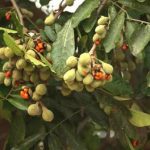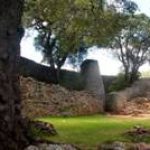Tree Life
December 1981
MASHONALAND CALENDAR
Tuesday December 1st : Botanic Garden Walk. Meet in the Car Park at 1645 for 1700 hours.
Saturday December 5th : The message from the Prime Minister includes the following words “Our trees provide fuel and building materials, fruits and also shade and shelter. They protect our soil and water supplies. In order to ensure that they continue to do so it is our duty to plant more trees than are being cut down or destroyed.” The Makabusi Woodlands Association is to hold a Tree Planting Ceremony in the north west corner of the Woodlands at the site of the future interpretive services complex at 1000 hours. The Guest of Honour will be the Mayor of Salisbury. Please watch the Press in case there are any last minute changes of time.
Directions : Cross the railway line going south on Glenara Avenue, first left into ITV Road and the gate is the first one on the right hand side. The site of the Ceremony will be obvious. With all that the Makabusi Woodlands means to this Society I believe it would be appropriate for us to attend this Ceremony. If however you would rather attend one closer to you please do so. NOTE : In future the National Tree Day will be held on the first Saturday in December each year.
Sunday December 20th : Craighill. Although we do not usually have a December outing Paul and I would be delighted for you to join us for morning tea and have a wander round and see how the trees have grown since you were last here. If you would like to bring a picnic lunch and make a day of it you will be very welcome to do so.
Tuesday 26th January 1982 : Notice is hereby given that the 32nd Annual General Meeting of the Tree Society of Zimbabwe will be held on Tuesday, 26th January 1982, at 2000 hours in the Auditorium of the queen Victoria Museum, Salisbury.
In terms of the Constitution I am required to give you 30 days notice of the AGM –so the next newsletter would be too late. However, it is only necessary for you to receive 14 days notice of the Agenda so I do have time to include that in the next Newsletter.
BOTANIC GARDEN WALK ON 3RD NOVEMBER
The group was led on a tour of species likely to be encountered on the forthcoming Shamva trip.
Our first stop was Terminalia zambesiaca, a Zambezi valley species. It is the only Zimbabwean Terminalia with a smooth bark, and is a most distinctive tree, having it branches arising, as it were, in groups at different heights giving a layered effect.
Ficus sansibarica is a fig unfamiliar to most of us. There is a forest form and a woodland form of this species – the size of fruit and shape of leaves differentiating the two. Figs grow directly out of the stem of the species, not on special branches as in Ficus capensis.
Ficus capreifolia is also expected in the riverine areas we will visit. It is the “sandbinder” of river beds – wherever a branch touches the sand it roots, and eventually forms a spreading tangle of branches and very rough feeling leaves.
Albizia harveyi is one of the very fine leafed albizias. At first sight it may be indistinguishable from A. amara, but closer examination reveals (with the aid of a magnifying glass) that the midrib of the leaflet is off centre in A. harveyi but central in A. amara.
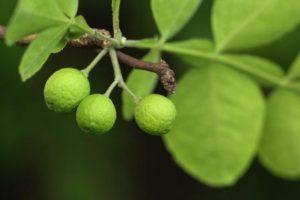
Citropsis daweana. Photo: Bart Wursten. Source: Flora of Zimbabwe
Tom then showed us an unusual little jesse-bush tree, which we are unlikely to see as it is uncommon. This is Citropsis daweana a member of the Rutaceae or citrus family. This shiny leafed little bush with its markedly winged rachis and aromatic pellucid glands clothing the leaves, had a very strong citrus smell and small lemon-like fruit. This, and the several other citrus species indigenous to Zimbabwe have been long considered “useless” plants. But there is now some interest being shown in them as root stock on which to graft commercial citrus.
Oxytenanthera abyssinica, the wild bamboo, is one of only two bamboo species occurring in this country. Its distribution is limited, but there were at one time large groves of it in the Shamva-Bindura area. However, some years back it all flowered and then died simultaneously, as is the way with bamboo. It is said to be showing signs of regeneration now, but it remains to be seen how long it is to the next flowering (bamboo incidentally is a member of the grass family).
We will certainly expect to see marula on our trip. This marvellous tree produces very palatable, nutritious fruit, and also a high-quality nut for those who have the patience to do battle with the seed shell. It is a member of the ANACARDIACEAE family, to which mango, cashew and pistachio nuts belong. Its old familiar name Sclerocarya caffra, has apparently been changed back to the previous name of Sclerocarya birrea.
Lastly we went to witness the probable lasts season of the well established group of Holarrhena pubescens in the gardens. “Muti” hunters have completely ring-barked all the trees over the past few years. From the bark may be made a very potent aphrodisiac, so it is said, and there are no shortages of customers for its beneficial effects!!
-Cheryl Haxen
GOLDEN STAR FARM, SHAMVA, 15TH NOVEMBER 1981
I am indebted to Paul for this account of our November outing.
Going to the Shamva area in a hot month seemed a very brave thing to do. “You must be very keen to come here in November” was how our Shamva members and guests greeted us. But we did not find it too hot, whether we were too keen to notice or whether it was because we were in the shade of riverine trees for the hottest part of the day, I leave you to decide. This was on Golden Star farm, the home of Edne-Anne and Aubrey Logan.
Dick Petheram was our guide and mentor for the day as Edne-Anne is his daughter and the farm is a second home to him. With his usual thoroughness he had telephoned us the night before to give us details of interesting things we could see from the bus on the way out. One of these was the Bindura Bamboo. Let me say here and now that this common name has a good alliterative ring to it but that is the only good thing about it. It would be far better to call it just the Wild Bamboo as it has a distribution far beyond the Bindura District, including a lot of the Zambezi Valley and the Eastern Districts.
Oxytenanthera abyssinica is its scientific name and it is a most interesting plant. It is of a characteristically bamboo like structure growing in dense clumps and reaching a height of 13 meters, with each stem 5 – 10cm in diameter. There is considerable evidence that each plant flowers only once and then dies, but the flowering times may be as one Shamva farmer had observed, as far apart as 30 years and records agree with this but also say that the intervals can be as ‘short’ as seven years. Certainly the last time all the bamboo near Bindura flowered, they then died and Meg and I were lucky enough to observe the same thing in Umtali. It also seems that the plants in one area flower and then die together, but how large that area is not recorded. Certainly the data of the flowering near Bindura is not the same as those near Umtali. The flowers appear in the axils of the leaves and when the oat like fruit is formed the tips of the bamboo bend right over with their weight. The seeds are distributed by animals and water and germinate the following year after the plant has died during winter. The styles in the flowers are hollow, a unique feature which sets this species apart from the others.
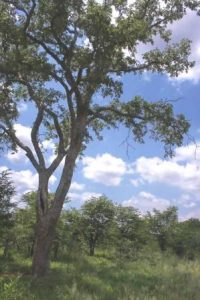
Xeroderris stuhlmannii. Photo: Bart Wursten. Source: Flora of Zimbabwe
When we arrived at the farm Dick first took us to his favourite kopje where we saw two things of great interest –Xeroderris stuhlmannii with its leaflets tending to be bigger at the base. The pods have a broad wing around their circumference, like the continental shelf around a continent, which is fascinating but the really characteristic feature is that the swelling for the seed is quite definitely rectangular in shape. Those pods are very prone to be parasitized which makes them turn into galls resembling berries. It is possible to find a whole tree covered in berries with no pods at all which can be very confusing. Usually, however, careful examination will reveal some pods which give the game away. Secondly, there were some fine specimens of Sterculia africana in fruit, which are made up of 1 to 3 to 5 boat shaped bladders each up to 15cm long, khaki, hairy on the outside, splitting down one side only, the split lined with hard hairs which are intensely irritating. The fat blue-grey seeds resembling engorged ticks are attached only around the edge of the opening; these are so life like they have given it the name tick tree. The bark is quite beautiful, silvery white to oyster-coloured with predominantly purple patches but also often peeling to reveal pastel colours of all shades.
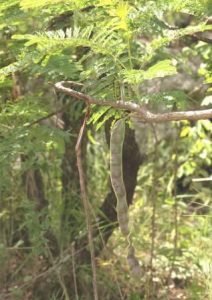
Elephantorrhiza goetzei. Photo: Bart Wursten. Source: Flora of Zimbabwe
We then went to the homestead where we were served a sumptuous tea and eats and Dick showed us some specimens of trees that we would not be able to see that day as it would be impossible to cover the whole farm, from which he has now recorded 180 species. Next we had a quick look at a few trees so close to the house that they were within the security fence; Holarrhena pubescens, the Wild Jasmine, in full flower and jasmine-like in both appearance and scent; Elephantorrhiza goetzei with young beans still not filled out, resembling 60cm long belts and a Marula, Sclerocarya caffra, which one could better identify by looking down rather than up as its old fruits were all over the ground. They are famed for their ability to make Marula wine, a drink of some alcoholic potency and there are stories of game becoming intoxicated by feeding on rotting fruit lying on the ground. Each fruit has a single stone in which there are two to three seeds, rich in protein.
We then boarded the bus and went down to the Mazowe River. We had to carry our picnic baskets the short distance from the bus to the river’s edge but, for some of us, this was no hardship at all as there were many interesting trees along the way. It was a beautiful place, densely shaded and overlooking a tranquil pool which was named Crocodile Pool for a very good reason. By this time it was 1230 hours so we decided to have lunch there and then go for our main walk immediately afterwards. It really was hot but a short lunch break with plenty of liquid refreshment made us eager to be off.
We met fascinating friends immediately. Ficus capreifolia, River Sandpaper Fig, with its very rough leaves which dry out to crumbling stage within a half hour of being picked; the yellow veined leaves of Garcinia livingstonei, the African mangosteen, only about 10 feet tall but much bigger than those we had seen at Raffingora where they were below knee height. This is supposed to have the most tasty fruit but this is only the second occasion we have seen it, our usual species being Garcinia buchananii the Granite Garcinia, whose fruit are very tasty anyway. The Garcinias can always be readily recognised if one picks a leaf when a distinctive bright yellow sap is exuded. Right next to them in botanical order is Harungana madagascariensis which has a bright orange, print like sap but is only found in the Eastern Districts. To return tour fascinating friends there was the River Rhus, R. quartiniana, Salix subserrata, the willow, and Nuxia oppositifolia, always riverine, with its very opposite leaves. Today it greeted us with lovely little posies of white flowers 3 to 5cm in diameter.
There were many very special friends also. To me, the highlight of the day was Flacourtia indica which we meet often as a slender sapling 7 to 10 feet in height with velvety leaves, but today they had trunks of 6 to 9 inches in diameter which were covered with thorns. Thorns growing upon thorns making a complex impenetrable mass standing out an extra 9 inches all round the stem. Meg and I have seen this only once before on Ceres farm, interestingly also in the Shamva district, also riverine and not very far away cross country, and we did so want to show you all when we visited the neighbouring farm Woodlands, but were not able to. Now here they were for all to see, it warmed our hearts.
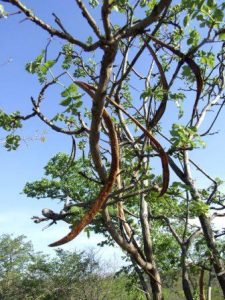
Markhamia acuminata. Photo: Rob Burrett. Source: Flora of Zimbabwe
Markhamia acuminata, the Bean Tree, cooperated so magnificently as to be in plentiful deep-throated maroon splashed flower while still having a lot of last year’s beans to show us what its common name is all about. The wood is used for roofing timbers and implement handles which could explain the one we found later in the afternoon which had been callously cut down.
Bequaertiodendron magalismontanum is known as the Stem-fruit because it flowers and then fruits all along its stem. Today we found one which was producing flower from its main trunk which really gave a clue to its name. Leaves were also found with the waxy bloom coating them which is like a clinging powder and can be wiped off to reveal the glossy green surface below. This species we meet often, riverine and in kopjes, its long leaf quite distinctive and beautiful, being dark glossy green above and silvery brown below.
Bonus after bonus. There were numerous Schrebera trichoclada in full Wooden-pear fruit, which had all split open and, as one member so aptly remarked, so resembled the jaws of a yawning hippo, but the pear shape still could be seen; Dalbergia melanoxylon, the black wood Dalbergia, with its small roundish leaflets and pale trunk, the heart-wood is purplish, soon darkening to black on exposure to light and is the wood most often used for ‘ebony’ carvings as it is easier to carve than real ebony.
We climbed the river bank at an easy place and came back along the top. We immediately found a number of species we had not seen down below. Artabotrys brachypetalus with its outstanding climbing hooks, which instead of being round tendrils are rectangular and woody with definite square corners. Even more interesting, these hooks are actually the flower stalks and the flowers and then the fruits are borne on them which has given the common name of Hook-berry. This also gave us a bonus in that the hooks were both flowering and fruiting. The incipient pest Xeromphis obovata displayed itself to us in flower, which was so like that of Gardenia that we could see how closely the two are related.
Now for the species we were not able to identify and have subsequently done so at the Herbarium. On the riverine walk the two creepers closely associated with each other, the one having Combretum-like fruits, sometimes with 5 wings was C. mossambicensis, the one that has white shaving brush flowers; intertwined with it having masses of nondescript flowers was Hippocratea africana. The previous creeper we had seen was C. paniculatum, the real Burning Bush which flames its scarlet flowers all over the Lowveld. On the top of the river bank we found a Terminalia-like tree with its leaves so crowded at the ends of the branches that we could not tell if they were opposite or alternate. This, believe it or not, was Turraea nilotica, not tipping us with the pinched base nor the drawn-string look to the leaves. The Schrebera was trichoclada as we knew it must be and the delightful little ground orchid with white petals was Eulophia quineensis var purpurata. It is very interesting to note that this is the first record for that area and it has previously only been found at Victoria Falls, Urungwe and the Umvumumvu River.
We packed up and went back to the bus, having to make a detour because of some angry bees in a hole in the path and then back to the homestead where, once again, we had tea and a tremendous spread of eats. What wonderful hosts to us the Logans were. Fine food, fine company, fine hospitality and, above all, very fine trees.
-Paul Coates Palgrave
Thank you Paul, for that account of a memorable day and thank you Edne-Ann, Aubrey and Dick for making it so.
MATABELELAND BRANCH CALENDAR
Friday December 4th : The Annual General Meeting of the Bulawayo Branch of the Tree Society of Zimbabwe will take place on Friday, 4th December, at 1715 hours at 6 Caithness Road, Hillside. The normal business of an annual general meeting will be conducted. The Committee requests you to make arrangements for Tree Day tree planting.
Sunday December 6th : When did you last see the fascinating Kalahari Sand vegetation? A field meeting at the Chesa Forest Reserve has been arranged; if wet underfoot, it may be passable for private cars; if dry sandy conditions prevail, the Forestry Commission Land Rover will take us around, cars being left at the entrance. A gravel road goes through from here to Nyamandhlovu. Meet at Modern Motors at 0830 hours. Half or all day programme.
ACCOUNT OF THE FIELD MEETING ON 1ST NOVEMBER 1981
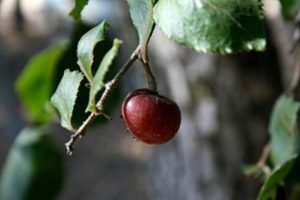
Flacourtia indica. Photo: Mark Hyde. Source: Flora of Zimbabwe
The site of the Jesuit Mission which is 24km south of Bulawayo is near to the original ’Old Bulawayo” and lies between the Matopos and Johannesburg roads. It is a National Monument and is on a ridge of ground with a beautiful view southwards to Thabas Inyorka and the Balla Balla peaks, blue in the distance. As explained by Mr. P. Stidolph, this rough country is an old volcanic area with shallow, infertile soil. There are out crops of rocks, their edges up ended like leaves of a book, caused by folding over the centuries. It is also a catchment area for rivers flowing into the Limpopo river. As we approached it looked lonely and deserted, and we were struck to find a large alter with white marble top, a large white cross erected as a memorial in 1875; it faced a grassy area which sloped gently away. Behind this one can see the black stone remains of the mission buildings. Rainsford describes their chapel as having a thatched roof supported on beams obtains from the ’forest’ at the base of Thavas Inyorka, and being 20’ x 10’. He describes how the mission made few converts and moved to Empandeni in the south west of the country in 1887. Six years prior to this Lobengula had moved his capital to a new site where Government House stands today, because the “grazing and the firewood around Bulawayo were becoming exhausted”. Recently the ruins area was cleared of Opuntia megacantha. There is a line of Kirkia acuminata trees which was apparently a fence of truncheons. A well grown Celtis africana, not very common in our area, and two species of Erythrina –latissima and lysistemon grow there. A short distance from the ruins are two graves, one for a Jesuit priest and the other for Jan Scheppers, a Hottentot hunter who died of leprosy. One can guess at the hard life they lived there; no doubt the traditional diet of meat and meal was supplemented be edible fruits growing on the surrounding hills, such as Flacourtia indica, Grewia flavescens, Mimusops zeyheri, Pappea capensis, Diospyros lycioides, Dovyalis caffra and D. zeyheri, Carissa edulis, Vangueriopsis lanciflora and Rhoicissus tridentata. The pods of Bauhinia thonningii ground to a powder may be eaten raw and this is valuable on a journey; Cassine matabelica leaves are said to be used to flavour stews, and what about Ximenia americana – can it be considered a food? On termite mounds we found additional things, Apodytes dimidiata, Olea europea, Peltophorum africanum and Schrebera alata. In places, the vegetation was similar to that on the Essexvale hills with Diplorhynchus condylocarpon, Acacias, Albizias and Combretum. There was a fine specimen of Ormocarpum trichocarpum, large enough to have been growing when Lobengula was alive, and a fine old Cassine transvaalensis too. We found Elephantorrhiza goetzei which surprised us, as we have previously only found it growing on granite dwalas in cracks. Was it perhaps brought from the nearby Matopos Hills as it is known to be useful ingredient of herbal remedies. Its spurs of cream coloured flowers were striking; so too was the Securidaca longipedunculata in bloom. Did the tribe die of malaria, and if so, we wondered if they used an infusion of Crossopteryx febrifuga for his bouts of fever?
-N.E.B. and J.I.W.
I should like to take this opportunity to say Greetings and Best Wishes for a very happy Christmas from us both.
-Meg Coates Palrave. Chairperson


